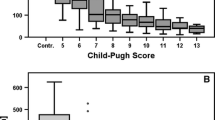Summary
The correlation between the amount of asialoglycoproteins and results of conventional liver function tests was studied in patients with chronic liver diseases, with or without hepatocellular carcinoma. The objective was to determine the clinical significance of the measurement of levels of serum asialoglycoproteins. The levels were elevated in accordance with the progress of liver diseases, and correlated with the decrease in albumin content, cholinesterase activity, the ratio of esterified cholesterol to total cholesterol and to the increase of indocyanine green retention at 15 min (p<0.001). There was no correlation with values of glutamic oxaloacetic and pyruvic transaminases. The amount of serum asialoglycoproteins also correlated with survival time in fatal cases of cirrhosis and/or hepatocellular carcinoma.
Bilirubin and bile acids did not interfere with the measurement of serum asialoglycoproteins in cases of hyperbilirubinemia.
Serum asialoglycoprotein levels are a good indicator of hepatic functional reserve in patients with chronic liver diseases, with or without hepatocellular carcinoma.
Similar content being viewed by others
References
Neufeld EF, et al: Carbohydrate recognition systems for receptor-mediated pinocytosis. In: Lennarz WJ, eds. The biochemistry of glycoproteins and proteoglycans. New York: Plenum Press, 1980, 241–266
Ashwell G, et al: Carbohydrate-specific receptors of the liver. Ann Rev Biochem 51: 531–554, 1982
Marshall JS, et al: Measurement of circulating desialylated glycoproteins and correlation with hepatocellular damage. J Clin Invest 54: 555–562, 1974
Marshall JS, et al: Serum desialylated glycoproteins in patients with hepatobiliary dysfunction. J Lab Clin Med 92: 30–37, 1978
Arima T, et al: Serum glycoproteins in the liver diseases. V. Desialylated glycoproteins in chronic hepatitis. Gastroenterol Jpn 13: 503–506, 1978
Arima T, et al: Serum glycoproteins in the liver diseases. VIII. Desialylated glycoproteins in the liver cirrhosis. Gastroenterol Jpn 14: 349–352, 1979
Sobue G, et al: Asialoglycoproteinemia in a case of primary hepatic cancer. Hepato-Gastroenterology 27: 200–203, 1980
Bordas MC, et al: Evaluation of the degree of desialylation of serum α1-acid glycoprotein and α1-antitrypsin. Clin Chim Acta 125: 311–318, 1982
Sawamura T, et al: Decrease of a hepatic binding protein specific for asialoglycoproteins with accumulation of serum asialoglycoproteins in galactosamine-treated rats. Gastroenterology 81: 527–533, 1981
Sawamura T, et al: Hyperasialoglycoproteinemia in chronic liver diseases and/or liver cell carcinoma asialoglycoprotein receptor in cirrhosis and liver cell carcinoma. Gastroenterology 87: 1217–1221, 1984
The Japan Society of Hepatology. Chronic hepatitis: The proceedings of the 6th Inuyama symposium. Tokyo: Chugai Medical Press, 1975
Sherlock S: Diseases of the liver and biliary system. 5th et. Osney Mead, Oxford: Blackwell Scientific Publications, 1975
Sawamura T, et al: Some properties of a binding protein specific for asialoglycoproteins and its distribution in rat liver microsomes. Cell Struct Funct 5: 133–146, 1980
Hudgin RL, et al: The isolation and properties of a rabbit liver binding protein specific for asialoglycoproteins. J Biol Chem 249: 5536–5543, 1974
Doumas BT, et al: Standardization in bilirubin assays: Evaluation of selected methods and stability of bilirubin solutions. Clin Chem 19: 984–993, 1973
Seltzer HS, et al: Insulin secretion in response to glycemic stimulus: Relation of delayed initial release to carbohydrate intolerance in mild diabetes mellitus. J Clin Invest46: 323–335, 1967
Hunton DB, et al: Studies of hepatic function with indocyanine green. Gastroenterology 39: 713–724, 1960
Moody FG, et al: Estimation of the functional reserve of human liver. Ann Surg 180: 592–598, 1974
Rikkers LF, et al: Estimation of functional hepatic mass in resected and regenerating rat liver. Gastroenterology 67: 691–699, 1974
Paumgartner G: The handling of indocyanine green by the liver. Schweiz Med Wschr 105 supple, Fase 17: 1–30, 1975
Author information
Authors and Affiliations
Rights and permissions
About this article
Cite this article
Sawamura, T., Kawasato, S., Tsuda, M. et al. Clinical application of the measurement of serum asialoglycoproteins to estimate residual liver function in patients with chronic liver diseases with or without hepatocellular carcinoma. Gastroenterol Jpn 20, 201–208 (1985). https://doi.org/10.1007/BF02774705
Received:
Accepted:
Issue Date:
DOI: https://doi.org/10.1007/BF02774705




